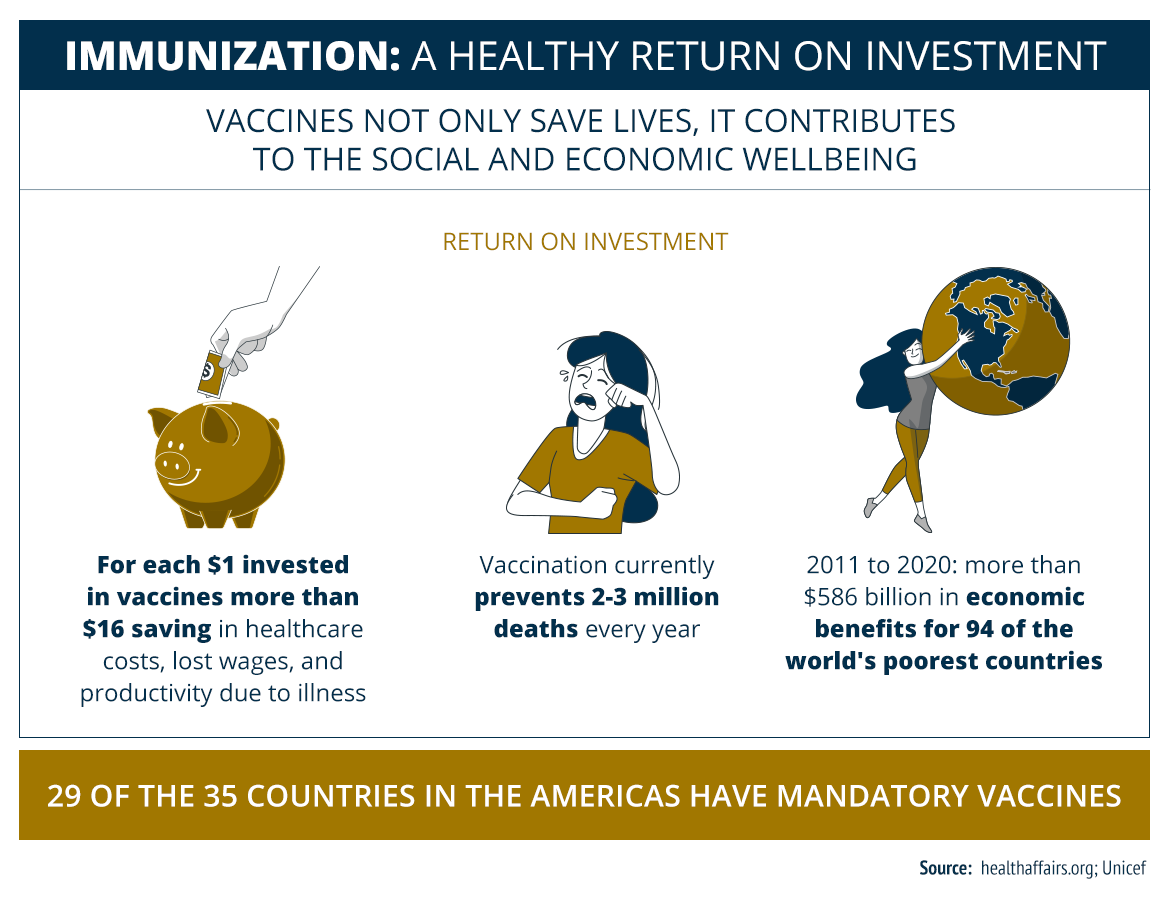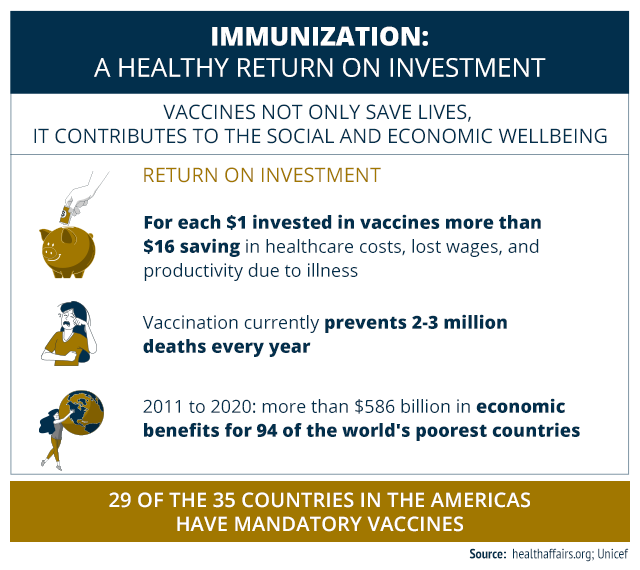15 Sep 2021
Vaccines: The Most Cost-Effective Way to Save Lives
Estimated read time: 6 minutes
For more than 3,000 years, smallpox – an infectious disease that causes painful skin lesions – killed three out of every 10 people who contracted it. Many of those who were lucky to survive were left with permanent scars on large areas of their bodies, particularly the face. Some even became blind.
Since 1977, there have been zero cases of naturally occurring smallpox, and today the disease is considered eradicated. How was this achieved? It was all thanks to the most cost-effective and efficient public health tool available: vaccines.
Through biological mechanisms that “train” the human immune system to fight pathogens that cause illness, vaccines have helped eradicate, eliminate, or control approximately 20 diseases that previously put millions of lives at risk. The measles vaccine alone helped prevent 23 million deaths worldwide between 2010 and 2018.
Vaccines generate seasonal immunity, like the flu shot, which must be applied each year; middle-term immunity, as is the case for the tetanus shot; and long-term immunity, like the measles vaccine.
Vaccination does more than just protect an individual: when an entire community is vaccinated, that population achieves what’s known as “herd immunity” or collective immunity. In other words, the people who are vaccinated create antibodies that form a kind of protective shield that prevents illness.
Immunity and Protection Starts In Childhood
Vaccines also free public health systems from the heavy and unnecessary burden of treating illnesses that can be prevented through vaccination.
Reaching immunity against diseases such as cholera, diphtheria, polio, mumps, and meningitis, among others, is a public health process that usually starts in childhood. Most countries have immunization schedules and campaigns, and children are vaccinated from birth through the end of adolescence, strengthening their immune systems with each dose.

There are usually some vaccines that are mandatory, meaning kids are required to receive them at birth and prior to entering the school system. These vaccines are very safe — children are much more likely to get sick from a disease that could be prevented through immunization than to suffer any negative effects due to the vaccine itself. All vaccines must undergo extensive and strict safety testing, including clinical trials, before they can be approved for use. Only vaccines that meet rigorous standards for both quality and safety can be distributed by countries.
The field of vaccine research is massive and constantly evolving. The following is a list of vaccines that are currently part of most childhood immunization schedules:
- Tuberculosis
- Diphtheria
- Hepatitis B
- Influenza
- Encephalitis
- Measles
- Meningitis
- Mumps
- Whooping Cough (Pertussis)
- Pneumonia
- Polio
- Rabies
- Rotavirus
- Rubella
- Tetanus (Lockjaw)
- Typhoid Fever
- Chickenpox
- Yellow Fever
- Cholera
- Human papillomavirus (HPV)
Parents should vaccinate their children in accordance with their country’s immunization schedule. Delaying vaccination can put children at risk of contracting serious illnesses that vaccines prevent.
Country’s Immunization Schedule:
If a child skips a vaccine dose, parents should alert their physician. Kids can get more than one shot during a single doctor’s visit, although in many cases several can be combined in a single injection. One vaccine, for example, combines the whooping cough; diphtheria; tetanus; polio; and Haemophilus influenzae type B vaccines in a single shot. Getting multiple vaccines at the same time is simply a way of reducing the number of injections needed and does not compromise their efficacy or safety.
Adults also need to get vaccinated, but the vaccines required in the first decades of life constitute the foundation for stronger societies and individuals.
Latin America: Key Facts
Even though vaccines are generally cost-effective, and in many cases subsidized by governments, approximately 20 million children in the world do not receive a full course of even basic vaccines, and many more miss out on newer vaccines, each year..
The region of the Americas has one of the highest vaccine coverage levels in the world. By way of example, in 2018, around 88% of children aged under one year received the three required doses of the DTP3 vaccine, which protects against diphtheria, tetanus, and whooping cough. However, in spite of this, many hard-to-reach populations are left behind, especially those who live in rural or jungle areas located far from urban centers. According to the Pan American Health Organization (PAHO), 1.4 of the 15 million children living in the Americas do not complete their vaccination schedules.
The importance of vaccines, and the value they bring, is difficult to overstate. They are incredibly easy to administer — people can get them at hospitals, doctor’s offices, schools, pharmacies, and in the case of the COVID-19 vaccine, even museums and amusement parks. Most importantly, vaccines have significantly and dramatically reduced the incidence and mortality of many communicable diseases.
Each year, 3 million lives are saved thanks to vaccination. In developed and developing countries alike, vaccination has been and continues to be the most effective tool for the prevention of serious illnesses.
The Dangers of Not Getting Vaccinated
When people don’t get vaccinated or fail to vaccinate their children, the solid foundation of collective immunity is shaken, leading to outbreaks of vaccine-preventable diseases previously declared eliminated. In 2015, for example, 60 people became infected with measles in Disneyland and one other theme park in California.
As before, the consequences are not just at the individual level; they impact us collectively. In the United States, COVID-19 cases and hospitalizations continue to increase among children, many of them between the ages of 12 and 15 years old, the youngest members of the population for whom the vaccine is currently approved. Timely vaccination could likely prevent further health complications and rising healthcare costs.
For public health experts, vaccines are simply a means of preventing disease. But economists have a different and interesting perspective: illness prevention and positive health outcomes derived from vaccination are an important long-term investment. According to research, every dollar spent on childhood vaccination saves $3 from a payer perspective and $10 from a societal perspective. Similarly, every dollar spent on vaccination in 94 low- and middle-income countries saves $16 on healthcare costs.
Evidence has shown health to be a principal driver of economic growth. Improving our health, largely through vaccination, can have important economic and social benefits: longer careers, productivity gains, better educational outcomes, increased inclusivity, and lower healthcare costs.
For GAVI, The Vaccine Alliance, the message is clear: vaccination is one of the most cost-effective ways to save lives, improve health, and ensure long-term prosperity.
Remember, always consult with your physician or health care professional to determine the best options for your body and health and to answer any questions you may have regarding any medical matter, including vaccines.




